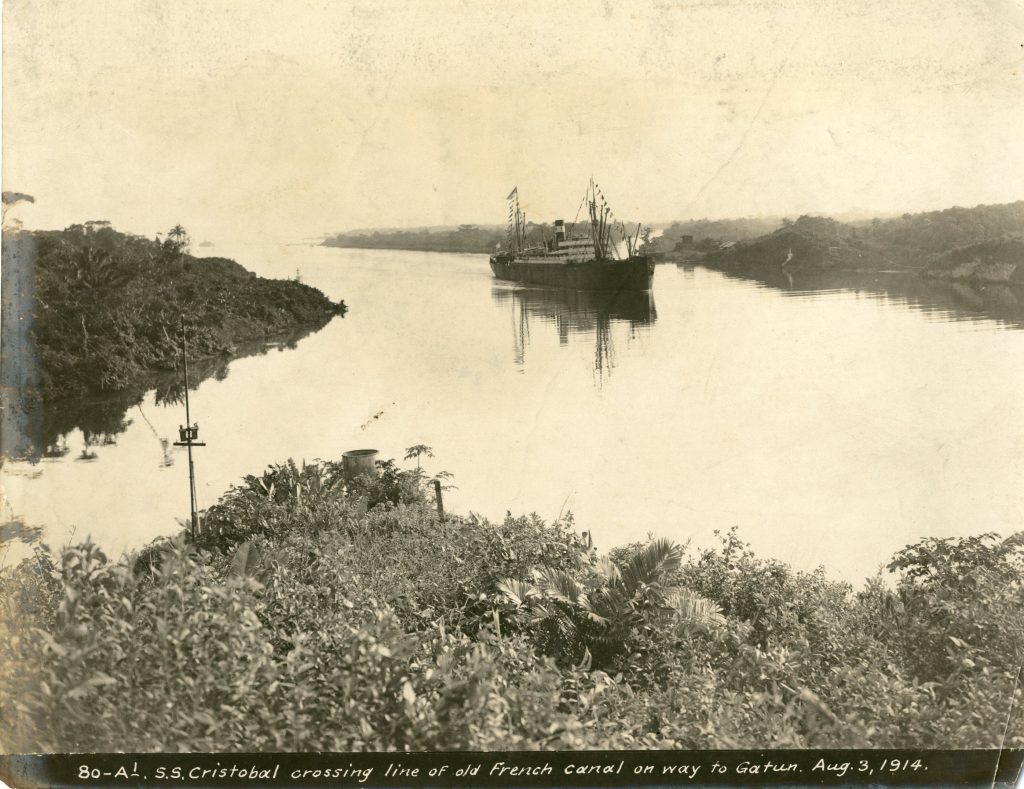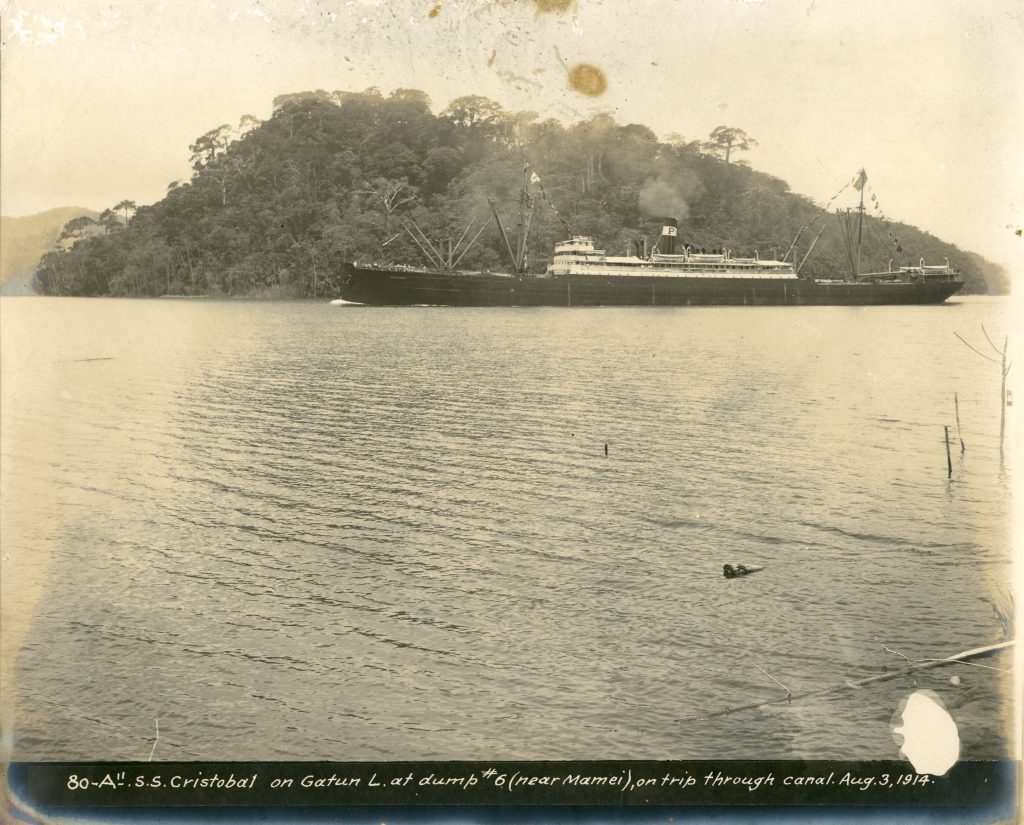110 years ago this month…

One hundred and ten years ago this month, the Panama Canal officially opened. On Saturday, August 15, 1914, the S.S. Ancon left Cristobal dock No. 9, and approximately nine hours and 40 minutes later, it arrived five miles out into the Bay at Panama, at the end of the dredged channel. On board were around 200 people including politicians, military officials, and high ranking affiliates of the Panama Canal.

The August 15th, 1914 transit of the S.S. Ancon is the celebrated event, but there were other test voyages and “firsts” that occurred in the weeks and months prior, most notably the the August 3rd, 1914 trip of the S.S. Cristobal. Although it technically (and purposefully) did not sail the full length of the Canal so that the Ancon could claim that prize, Chief Engineer George Goethals wanted a ship to complete a trial run before the eyes of the world were on the Canal and the workforce that had labored for ten years to design and dig this new modern marvel.


A description of the test trip is included in the August 5th issue of the Canal Record.

John O. Collins shared his alternative theory of the August 3rd transit in the Society of the Chagres 1914 Yearbook, speculating that this “test voyage” was to give the individuals who had actually worked on the Canal the opportunity to experience it instead of outside dignitaries and press.
The Society of the Chagres was a organization created to “keep alive the pleasant associations and memories connected with the work in which they have each spent six or more years of their lives…who have earned the Roosevelt Canal Medal and two bars prior to the official opening of the Canal.” Their yearbooks are a great place to learn about some of the Americans from the construction era.
Move through this slideshow of images of the Cristobal‘s trip with the left and right arrows.
Did you know that there is debate about whether the August 3rd or the August 15th trip carried the 50,000 medals struck to commemorate the completion of the Panama Canal? Although the official opening was the 15th, they are often referred to as the “Cristobal Medal”.


This medal was a gift of Sara Collinge Ulrich, 2002.23.3.
But what about those other “firsts”…
The S.S. Alliance was the first ocean going vessel to make lockage at the Panama Canal. It happened at Gatun Locks on June 8, 1914.

The Santa Clara tested the lockage through Miraflores and Pedro Miguel later in June, 1914.


An account in the Isthmian Historical Society Roosevelt Medal Holders’ Tape Recorder Guest Book references another first. It is unclear if Adrien M. Bouche is conflating two “firsts” or if he was mistaken about the year, but he recounts a unique experience he had watching one of these important events with Goethals himself. At the age of fifteen or sixteen Bouche watched the first lockage of Gatun Locks, a trip made by the tugboat Gatun on September 26, 1913.
Isthmian Historical Society. Roosevelt Medal Holders’ Tape Recorder Guest Book: The Word-for-Word Reminiscences of 35 Oldtimers Who Helped to Dig the Panama Canal. Recorded on Tape November 17, 1958.


Do you have any stories about these Panama Canal “firsts”?
If you want to learn more about these and other early “firsts” at the Canal enjoy this series of articles that Bob Karrer, Bill Fall, and Tag Stewart wrote for the Isthmian Collectors Club (ICC) Journal’s in 2011 called “The First Transits”. You can read the articles here or download a copy below.







4 Comments
Lee Paris
I enjoyed my 2 years as a cook , 15th Naval District. 1948-1950.
Laura Kosik
My great grand father (Charles Van Clief) was one of the men on the Ancon in 1914. He had come down to Panama in 1910 cuz he heard there was a job to do manual labor like thousands of others. They had asked him to steer it as an apprentice because he was going to be the tug master. His first daughter was born just 2 months before the official opening of the Canal. I would love to see a list of names of passengers on the “First” boats that went through the Canal.
Janice Grimison Scott
Despite U.S. national newspapers warning of malaria and yellow fever deaths at the Canal construction on the Isthmus of Panama, it did not deter my grandparents, Thomas I Grimison and his wife, Jessie, with 9-month old daughter, going to there in 1907, where they worked and raised their family (to include another daughter and son) for over fifty years. Tom was a conductor on a dirt train that took debris from dynamited areas like the Culebra Cut, and transported to fill the swamp that created Balboa and Fort Amador. He was a Roosevelt Medal recipient with 2 bars, and the couple were on one of the first canal transits in 1916. Tom’s name is listed at the Miraflores Locks visitor center honorarium to the construction workers. He retired as a Marine Traffic Controller and Jessie from the Commissary.
They always seemed to know everyone. I recall in 1954, how much they enjoyed the week of festivities which reunited many friends from the construction era who returned to the Canal Zone for the Canal’s 40th Anniversary and dedication of the Goethal’s Memorial in Balboa. I asked my grandmother, a coal miner’s daughter, what was life like in the early construction years. She replied, “It was the best time of my life!”
Although Tom and Jessie returned to U.S. occasionally to visit their families, they had purchased a weekend beach house in Nuevo Gorgona circa 1928 (which had been an obsolete Canal construction era house relocated there from the Gatun lakeside town of Gorgona). Many relatives traveled to visit them at their beautiful forever retirement home overlooking the Pacific Ocean, but the couple never returned to live in the U.S.
Lee Paris
Read a very interesting book on building the Canal but have no idea what the name was. A doctor found the Yellow Fever problem, named the mosqueter [SP] out of hundreds, it was a fresh water one that lived in the house plant potery. Enjoyed my 2 years as a cook at the 15th Naval Distric, 1948/1950. A bar on J street!!! And whatever her name was???